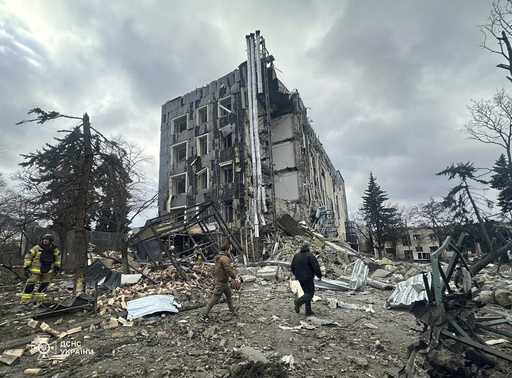
PAVLOHRAD, Ukraine — The former concert hall in this eastern Ukrainian town has been transformed into a makeshift shelter, where cots are set up on the stage. Instead of music resonating through the space, it is now filled with the quiet weeping of locals who have been forced to flee their homes due to the ongoing conflict that has been raging for nearly three years against Russia.
As the Russian army continues to advance, numerous towns and villages have been caught in the crossfire. The Pavlohrad concert hall has now become a temporary refuge for civilians escaping the constant barrage of Russian artillery.
“It’s good here. There’s food, warmth, and a place to wash,” said 83-year-old Kateryna Odraha, who recalls enduring the German occupation during World War II in her village.
However, this sanctuary may soon face significant challenges. Maintaining the shelter costs approximately $7,000 each month, with 60% of that amount funded by U.S. assistance aimed at supporting Ukraine.
The recent decision by President Trump to freeze humanitarian aid for three months has impacted places far removed from Washington, right here near the front lines in eastern Ukraine.
Trump’s directive abruptly halted numerous humanitarian, development, and security initiatives funded by the United States, leading to widespread repercussions globally.
“This news was abrupt and unexpected,” stated Illia Novikov, coordinator of the Pavlohrad transit center managed by the charity Relief Coordination Center. “At this moment, we have no idea what the future holds.”
The lost U.S. funding was crucial, covering expenses for evacuation vehicle fuel, wages for aid workers, legal and psychological aid, and travel tickets for evacuees seeking safety.
Typically, around 60 individuals utilize the shelter daily; however, in times of intensified bombardment, that number can surge to over 200, according to Novikov.
Many of those arriving have endured months in their basements lacking electricity, running water, and sufficient food.
Vasyl Odraha, 58, had remained in his village for several months, despite the increasing frequency of artillery fire and bomb strikes as the conflict encroached closer to their home.
Initially, he thought Trump would resolve the conflict swiftly once in office, something he claimed during the presidential campaign.
“We pinned our hopes on Trump’s election,” he shared, sitting beside his 83-year-old mother on a cot.
As the fighting escalated and the front lines came within 3 kilometers of their village, they made the choice to flee at dawn.
“If we hadn’t left, we would have died that very night,” declared Kateryna Odraha.
Throughout Ukraine, various sectors are grappling with the aftereffects of the aid freeze, adding pressure to the already strained wartime economy.
Programs supporting energy, veterans, mental health services, cybersecurity, healthcare, independent media, and border infrastructure are all feeling the impact. This aid was designed to mitigate the consequences of ongoing conflict.
Ukrainian President Volodymyr Zelenskyy has indicated that his administration anticipates a reduction in aid of approximately $300-400 million, primarily affecting the energy sector, which has been a target of Russian attacks.
Zelenskyy mentioned that Ukraine hopes to compensate for this deficit through support from European sources or domestic funding.
In response to the humanitarian crisis, the World Health Organization (WHO) recently launched an emergency initiative seeking to raise $110 million for its humanitarian efforts in Ukraine, where it reports nearly 13 million people are in critical need of assistance.
“The humanitarian crisis in Ukraine has reached a scale of undeniable severity,” the WHO commented in a statement.
Amid the intense conflict, a recent Russian missile attack on a civilian area in Izium, a city in the northeastern Kharkiv region, resulted in the death of five individuals and injured 50 others, including three children.
While U.S. military aid has not been affected, Zelenskyy has noted that Ukraine has only received about 42% of the funds approved by Congress.
Without indications that the war may soon cease, Ukrainian civilians will continue to require substantial assistance.
“Evacuations will continue for a long time,” Novikov reiterated. “There may be new front lines, new affected communities, so we must be prepared to keep providing assistance.”

